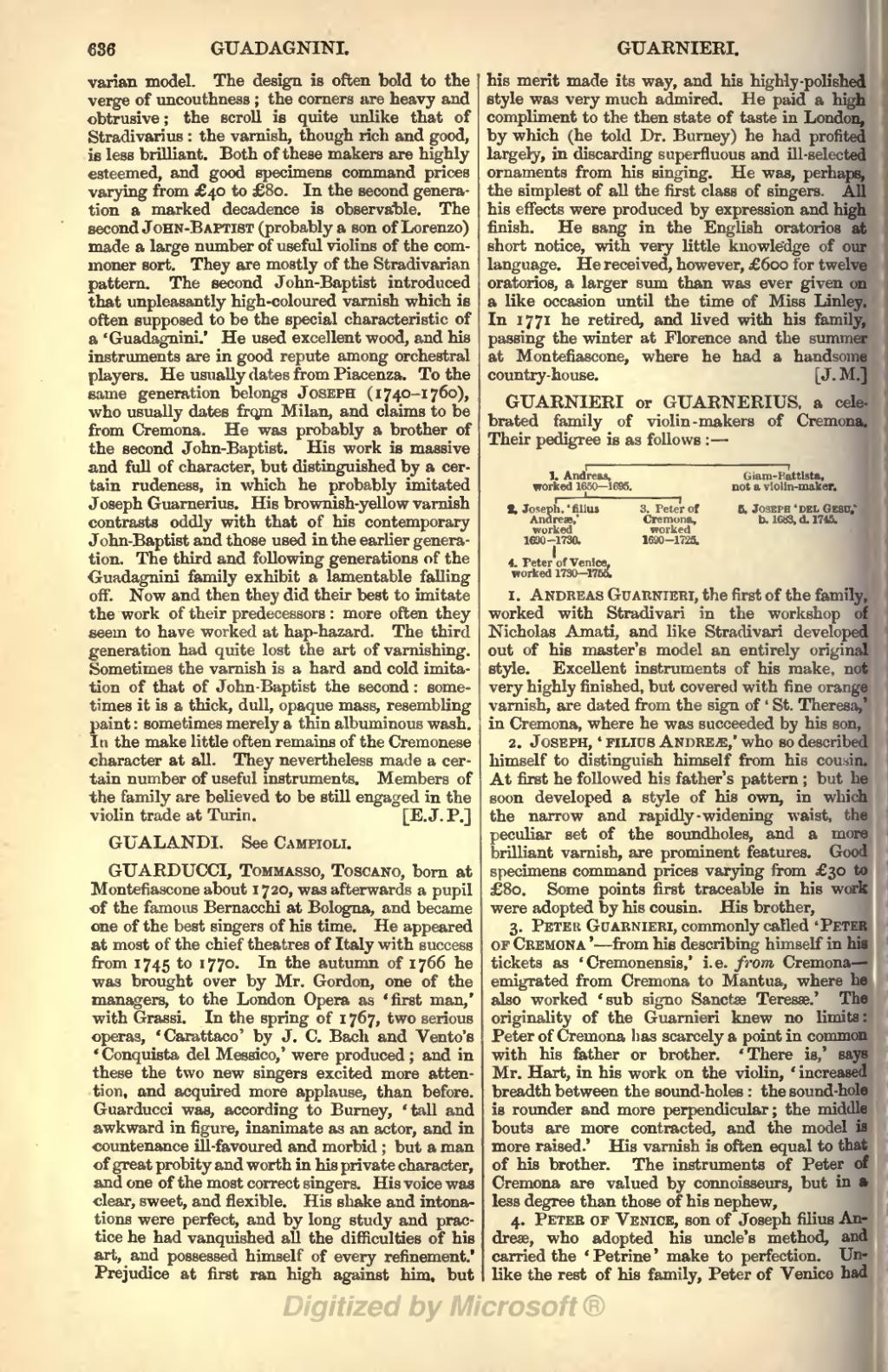varian model. The design is often bold to the verge of uncouthness; the corners are heavy and obtrusive; the scroll is quite unlike that of Stradivarius: the varnish, though rich and good, is less brilliant. Both of these makers are highly esteemed, and good specimens command prices varying from £40 to £80. In the second generation a marked decadence is observable. The second John-baptist (probably a son of Lorenzo) made a large number of useful violins of the commoner sort. They are mostly of the Stradivarian pattern. The second John-Baptist introduced that unpleasantly high-coloured varnish which is often supposed to be the special characteristic of a 'Guadagnini.' He used excellent wood, and his instruments are in good repute among orchestral players. He usually dates from Piacenza. To the same generation belongs Joseph (1740–1760), who usually dates from Milan, and claims to be from Cremona. He was probably a brother of the second John-Baptist. His work is massive and full of character, but distinguished by a certain rudeness, in which he probably imitated Joseph Guarnerius. His brownish-yellow varnish contrasts oddly with that of his contemporary John-Baptist and those used in the earlier generation. The third and following generations of the Guadagnini family exhibit a lamentable falling off. Now and then they did their best to imitate the work of their predecessors: more often they seem to have worked at hap-hazard. The third generation had quite lost the art of varnishing. Sometimes the varnish is a hard and cold imitation of that of John-Baptist the second: sometimes it is a thick, dull, opaque mass, resembling paint: sometimes merely a thin albuminous wash. In the make little often remains of the Cremonese character at all. They nevertheless made a certain number of useful instruments. Members of the family are believed to be still engaged in the violin trade at Turin.
[ E. J. P. ]
GUALANDI. See Campioli.
GUARDUCCI, Tommasso, Toscano, born at Montefiascone about 1720, was afterwards a pupil of the famous Bernacchi at Bologna, and became one of the best singers of his time. He appeared at most of the chief theatres of Italy with success from 1745 to 1770. In the autumn of 1766 he was brought over by Mr. Gordon, one of the managers, to the London Opera as 'first man,' with Grassi. In the spring of 1767, two serious operas, 'Carattaco' by J. C. Bach and Vento's 'Conquista del Messico,' were produced; and in these the two new singers excited more attention, and acquired more applause, than before. Guarducci was, according to Burney, 'tall and awkward in figure, inanimate as an actor, and in countenance ill-favoured and morbid; but a man of great probity and worth in his private character, and one of the most correct singers. His voice was clear, sweet, and flexible. His shake and intonations were perfect, and by long study and practice he had vanquished all the difficulties of his art, and possessed himself of every refinement.' Prejudice at first ran high against him, but his merit made its way, and his highly-polished style was very much admired. He paid a high compliment to the then state of taste in London, by which (he told Dr. Burney) he had profited largely, in discarding superfluous and ill-selected ornaments from his singing. He was, perhaps, the simplest of all the first class of singers. All his effects were produced by expression and high finish. He sang in the English oratorios at short notice, with very little knowledge of our language. He received, however, £600 for twelve oratorios, a larger sum than was ever given on a like occasion until the time of Miss Linley. In 1771 he retired, and lived with his family, passing the winter at Florence and the summer at Montefiascone, where he had a handsome country-house.
[ J. M. ]
GUARNIERI or GUARNERIUS, a celebrated family of violin-makers of Cremona. Their pedigree is as follows:—
1. Andreas, | Giam-Battista, | ||||||||||||||||||||||||||
2. Joseph, 'filius | 3. Peter of | 5. Joseph 'del Gesu,' | |||||||||||||||||||||||||
4. Peter of Venice, | |||||||||||||||||||||||||||
1. Andreas Guarnieri, the first of the family worked with Stradivari in the workshop of Nicholas Amati, and like Stradivari develops out of his master's model an entirely origina style. Excellent instruments of his make, no very highly finished, but covered with fine orange varnish, are dated from the sign of 'St. Theresa,' in Cremona, where he was succeeded by his son,
2. Joseph, 'filius Andreæ,' who so described himself to distinguish himself from his cousin. At first he followed his father's pattern; but he soon developed a style of his own, in which the narrow and rapidly-widening waist, the peculiar set of the soundholes, and a more brilliant varnish, are prominent features. Good specimens command prices varying from £30 to £80. Some points first traceable in his work were adopted by his cousin. His brother,
3. Peter Guarnieri, commonly called 'Peter of Cremona'—from his describing himself in his tickets as 'Cremonensis,' i.e. from Cremona—emigrated from Cremona to Mantua, where he also worked 'sub signo Sanctæ Teresæ.' The originality of the Guarnieri knew no limits: Peter of Cremona has scarcely a point in common with his father or brother. 'There is,' says Mr. Hart, in his work on the violin, 'increased breadth between the sound-holes: the sound-hole is rounder and more perpendicular; the middle bouts are more contracted, and the model is more raised.' His varnish is often equal to that of his brother. The instruments of Peter of Cremona are valued by connoisseurs, but in a less degree than those of his nephew,
4. Peter Op Venice, son of Joseph filius Andreæ, who adopted his uncle's method, and carried the 'Petrine' make to perfection. Unlike the rest of his family, Peter of Venice had

